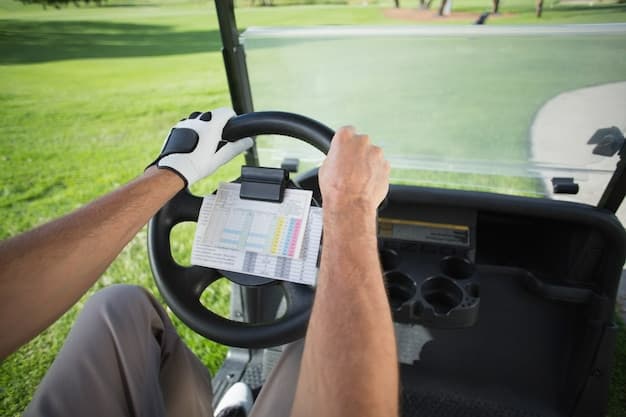Last updated on August 17th, 2023 at 01:36 pm
Golf carts, once relegated to the greens, have transcended their traditional role and are now used in various settings such as gated communities, resorts, and even road transportation. As their usage diversifies, so do the safety concerns associated with them.
This article delves into comprehensive research insights that shed light on the need for enhanced safety measures in the realm of golf cart operation. From addressing ejection risks to braking hazards on slopes, let’s explore how a proactive approach to safety can reshape the way we perceive and utilize golf carts.
The Need for Enhanced Safety Measures
In a 2018 study titled “Characterization of pediatric golf cart injuries to guide injury prevention efforts” published in the American Journal of Emergency Medicine by Joseph R. Starnes and his team emphasized the importance of specific safety features.
Their research found that:
Higher Hip Restraints: Preventing Unintended Falls
One of the key takeaways from the research emphasizes the significance of higher hip restraints. These restraints serve as a crucial barrier against passengers, especially children, from falling out of the cart during abrupt turns or sudden stops. By providing adequate support and containment, higher hip restraints play a pivotal role in averting potential injuries.
Seatbelts: Mitigating Ejection Risks
The study’s findings highlighted a disturbing trend of injuries caused by passengers being thrown out of golf carts during accidents. The inclusion of seatbelts emerged as a viable solution to substantially reduce such incidents. By ensuring that occupants are securely fastened within the cart, the risk of ejection is significantly mitigated, thereby enhancing overall safety.
Front-Wheel Brakes: Bolstering Stability
Unlike traditional golf carts that often feature rear-wheel brakes, the research accentuated the benefits of front-wheel brakes. These brakes offer superior stability, preventing the cart from tipping over during sudden stops. The enhanced control provided by front-wheel brakes not only minimizes the risk of accidents but also boosts passenger confidence while maneuvering the cart.
Balancing Popularity with Safety Standards
As the popularity of golf carts surges, particularly in gated communities and resorts, it’s imperative to strike a harmonious balance between convenience and safety. A study titled “Incidence of Golf Cart-Related Injury in the United States” conducted by G. McGwin and colleagues sheds light on the escalating concerns related to golf cart-related injuries.
The study’s findings underscore a marked increase in injuries associated with golf cart usage over the years. Among the most vulnerable demographic are children, who often lack the experience and understanding required for safe operation. To address this concern, the study strongly recommends the implementation of tailored safety courses, equipping younger users with the knowledge and skills necessary to navigate golf carts responsibly.
Addressing Safety Hazards in Road Transportation
The expanding role of golf carts in road transportation within certain communities raises a series of safety considerations. The study “Golf Cart-Related Injuries in a North Carolina Island Community” conducted by K. Passaro and team casts a spotlight on the potential hazards associated with this emerging trend.
One of the study’s crucial revelations is the pressing need for occupant restraints, not just for drivers but for all passengers. This measure is designed to prevent injuries during collisions and enhance overall safety. As golf carts integrate with regular vehicular traffic, the urgency of implementing such safety measures becomes increasingly evident.
Addressing Braking Hazards on Slope
Golf courses often encompass diverse terrains, including steep slopes that pose unique challenges for golf cart operation. The study “Braking Hazards of Golf Cars and Low-Speed Vehicles” conducted by K. Seluga and I. Ojalvo in 2006 draws attention to the potential risks associated with braking on downhill slopes.
The study emphasizes the significance of innovative braking solutions tailored for terrains with varying degrees of inclination. Without proper braking mechanisms, golf carts face the potential of gaining uncontrollable speed, endangering both passengers and individuals on the course. By implementing specialized braking systems, manufacturers can significantly reduce these risks and enhance overall safety.
Risks of Passenger Ejection
A significant concern associated with golf carts, particularly those without seatbelts, is the risk of passenger ejection. The study “Ejection of a Rear-Facing, Golf Cart Passenger” by K. Schau and O. Masory delves into this critical issue.
The research underscores the vulnerability of rear-facing passengers, particularly during sudden turns or stops. Many golf cart designs inadequately protect against such ejections, necessitating modifications to enhance passenger safety.
Recommendations include incorporating higher backrests and mandating seatbelt usage for all seating positions, thereby mitigating the risks of passenger ejection and related injuries.
Source:
- American Journal of Emergency Medicine
- pubmed.ncbi.nlm.nih.gov
- sciencedirect
Samantha Green is a golf expert who helps golfers improve their game by giving advice and suggestions on accessories.


